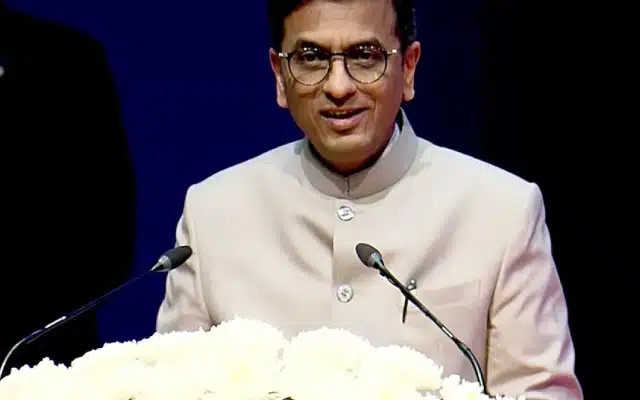New Delhi: Chief Justice of India DY Chandrachud spoke today to a special ceremonial bench in observance of the nation’s highest court’s 75th anniversary. The live-streamed event, which was structured like the Supreme Court’s first meeting in 1950, was attended by chief justices from every high court.
Three conditions have to be fulfilled, according to Chief Justice Chandrachud, for the Supreme Court to fulfill its constitutionally mandated responsibilities. The first is an independent judiciary, where the executive and legislative branches are powerless to sway the Supreme Court’s rulings.
The second is the judicial approach to adjudication, which holds that the Constitution should be interpreted by the Supreme Court as a living document rather than as a set of inflexible rules.
The third principle is that the Supreme Court must secure the respect of citizens for it to establish itself as a legitimate institution.
“The confidence of citizens is determinative of our own legitimacy… This court has in the last 75 years faced old and new challenges in confronting the face of injustice and meeting the expectations of those at the receiving end of power,” Chief Justice Chandrachud said.
“The Constitution entrenches several institutional safeguards for an independent judiciary… However, these constitutional safeguards are not in themselves sufficient to ensure an independent judiciary. An independent judiciary does not merely mean the insulation of the institution from the executive and the legislature branches, but also the independence of individual judges in the performance of their roles as judges,” the Chief Justice of India said.
“The art of judging must be free of social and political pressure, and from the inherent biases which human beings hold. Efforts are being made from within the institution to educate and sensitise judges across courts to unlearn their subconscious attitudes inculcated by social conditioning on gender, disability, race, caste, and sexuality,” Chief Justice Chandrachud said.
Chief Justice Chandrachud led the formation of the ceremonial bench for the first time today. Prior to the formal sitting, Prime Minister Narendra Modi took part in the program as well. As part of the festivities, the Supreme Court unveiled a new website.
Chief Justice Chandrachud outlined the two strategies the Supreme Court employs to boost public confidence in its legal system.
“First, by not conferring permanence upon judicial decisions, this court is cognisant that the law is not constant, but is ever-evolving. The space for disagreement is always open. In fact, the strongest jurisprudential developments of this court have undergone multiple rounds of litigation over the course of years, where the court has taken divergent views on questions of law.
“The second approach… has been to increase access to courts by diluting the procedural rules for the institution of cases. This court was opened up to citizens in every corner of the nation irrespective of their social and economic status. In 1985, 24,716 letter petitions were received in English, Hindi, and other regional languages. This number has since then undergone an exponential surge. In 2022, about 1,15,120 letter petitions were submitted to the Supreme Court, clearly indicating that the common person believes that they would be able to secure justice in these halls,” the Chief Justice of India said.
He agreed that the increase in access to courts does not necessarily translate into access to justice.
“This court has over the course of years faced immense difficulty in keeping up with the surge in the institution of cases. Currently, a total of 65,915 registered cases are pending before the Supreme Court. Much as we would like to reassure ourselves that the mounting pile represents the faith of citizens in the line, we need to ask hard questions on what needs to be done. There has to be a radical change in the approach to decision-making. In our desire to ensure justice in each individual case, should we risk the court becoming dysfunctional?” Chief Justice Chandrachud said.
“I believe that we have to have a common understanding of how we argue and how we decide and above all, on the cases which we select for decision-making. If we do not make hard choices and take difficult calls to resolve these pressing issues, the euphoria generated from the past may well be short-lived,” he said.
The Supreme Court is in the process of moving its digital records to a cloud-based system. Decisions will be freely accessible to the public in a digital format through the Supreme Court’s digital reports. There will be open access to all 519 volumes of Supreme Court reports published since 1950, totaling 36,308 cases, in digital format that can be bookmarked and easily navigated.
Read More
Karnataka High Court Warns Contractors on Slum Housing Projects

















